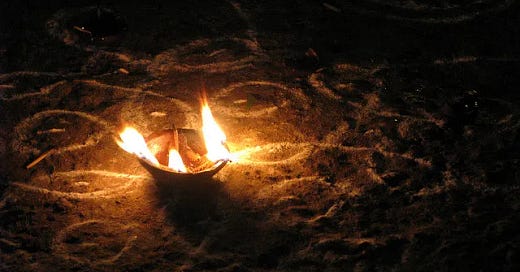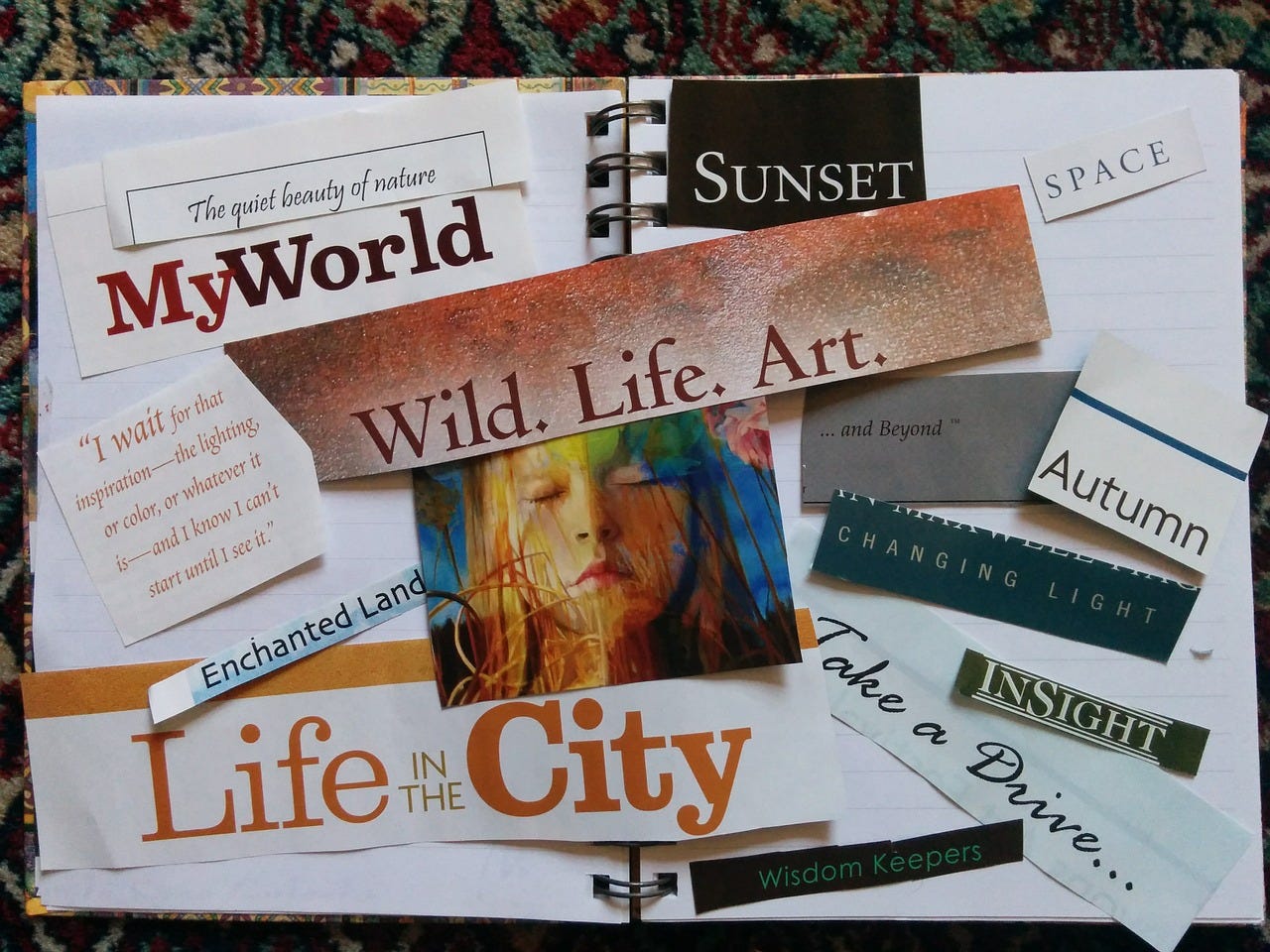Welcome to The Practice of Life — a place to slow down, befriend yourself, and connect with the world from kindness and awareness. Everything here is freely offered without paywalls. If you appreciate what you find here, please consider a paid subscription or one-time donation. Thank you!
December 15, 2024 / Full Moon
Well. It’s been quite the year, hasn’t it? Accelerated climate catastrophes around the planet, unspeakable violence in places including Gaza and Ukraine, a devastating U.S. presidential election, and more. And then there is whatever may have unfolded for us in our personal lives this past year. Taking time for a backward step and some deep breaths would be good medicine for all of us right about now.
These last few weeks of the year are a potent time to pause and look back at where we’ve come from and ahead toward where we’d like to go. Over a number of years, I developed my own Reflection and Intention process, refining the flow and the questions each year. When I was really on top of things, I would set aside a day at the turn of every season to go through this process. At the very least I would do this review once a year, usually the week between Christmas and New Year’s Day.
To be honest, I haven’t done this for a long while. I’m reviving it now to remind myself that I’d like to return to a more intentional way of living. So if you’re into this, I’ll be in the process right alongside you.
Not Your Usual Year-End Process!
It’s fairly common for people to do assessment and goal-setting this time of year. I’m purposely using the words “Reflection and Intention” to describe a process that comes from a different, more heart-based and impressionistic place.
Rather than making a laundry list of your achievements over the last 12 months, a reflective process is an invitation to explore the feeling tones of your year. It might even be quite poetic. What you’ve actually done is important, of course, but understanding the deeper waves of emotion and spirit that have washed through your life this past year can bring some catalytic insights.
The difference between intentions and goals (or resolutions) is similar. Intentions come from the heart and soul – they are rooted in the values that are most important to you. An intention is connected to your life’s purpose and is a specific way of expressing it at a given time in your life. Goals do have a role to play – if you want them to. They are an explicit manifestation of those intentions. But in this process they aren’t the starting point. I’ve found that my goals are much more powerful if I back myself up one step and first connect with my deepest intentions.
Once we’ve identified an intention and a goal related to it, objectives give us tangible ways to measure if we are meeting our goals.
Here’s how that might look. Let’s say I discern that my intention is to have vibrant good health, because that’s how I am best able to contribute to the world — and making a contribution is one of my core values. A goal I could set for that intention would be to exercise more consistently. An objective for that goal might be: go to the gym three mornings a week and do a cardio workout for at least 30 minutes.
What I’m about to describe is the process that has worked for me. I invite you to make it your own in whatever way feels right for you.
How to Do a Reflection and Intention Process
Part 1
If possible, give yourself a morning or afternoon to dive into this first part of the process. Go to a favorite place where you can be assured of solitude and quiet. Bring a journal and your favorite pen. You may want to bring your calendar from the past year as well as any journals you’ve kept to help remind you what’s transpired during this time.
If you have some kind of spiritual or contemplative practice that helps you connect with yourself like meditation or yoga, begin your day with that.
Then allow yourself time to reflect and write on the following questions:
What am I celebrating? What am I grateful for? What has been wonderful and magical about this past year?
What is one aspect about myself that I have especially loved this year? What am I proud of?
What would I have done differently this year?
What do I want to let go of?
What do I want to call in for the coming year?
Creating space to allow this process to unfold is crucial. Give yourself at least 30 minutes to journal on each question. Take a break between each question, return to your yoga or meditation practice for a while, or take a walk. Switching gears like this is balm for the creative and reflective self.
If you think you’ve come to the end of your writing after a short time, wait a few moments more and see what comes. If you need some prompts to get you further, you might want to use these categories: Spirit, Creativity, Relationships, Livelihood/Finances, Physical wellbeing. Explore each of those areas of your life in relation to the above questions.
What the questions are designed to do…
The first three questions are the reflective ones, questions that should evoke enough memories and thoughts to paint a meaningful picture of your life over the past year, and also to exercise your gratitude muscle. It’s fine to list some of the things that you’ve accomplished this year, but make sure to dig a level deeper to notice why those things are important to you, and how you got there. Did you have to break some old habits or patterns to do these things?
The fourth question begins to open the door for intentions for the new year. It recognizes the truth that we often have to let go of old beliefs, attitudes, and behaviors in order to make space for new ones to take root in our lives.
The fifth question is similar to goals and planning for the new year, but allow yourself to paint in fairly broad strokes here. This is all about vision and intention at this stage. Try to connect to your most heartfelt aspiration, both for your life and for the state of the planet right now. It really is okay to be as general as saying that you want to live in more abundance in the coming year, and that you envision peace on earth. You’ll get more specific in Part 2. As part of this fifth question, it can also be helpful to create a Vision Board (also known as a Dream Board) to give your intentions a visual dimension. You can do this the old-school way by tearing out images and words from old magazines and calendars, or check out this free digital vision board tool from Canva.
Part 2
After you’ve completed your reflection and journaling, let this process sit for a few days. Just like a good cup of tea, this needs time to steep inside you. Then set aside two or three hours, return to what you’ve written, and fill in more details for question #5. This is when goals and objectives take their place, if this is important to you. You might want to use a template like the one that
provides. Chris has been sharing his Annual Review process since 2005, and it’s fun to check out the ways we have similar and different approaches to it.If you’ve gone through the process described above, your goals and objectives will be firmly rooted in your deepest intentions, and that will provide you with an amazing spark throughout the year.
As you go through this process, please be gentle with yourself, both in the way that you reflect on your life — honesty, yes, but please, no harshness! — and also how you carry your intentions and goals into the new year. This is all about living from a place of love and intention, not willpower and grit.
As I said at the start, I’m planning to return to this process over the next couple of weeks. I look forward to sharing what I discover in my new moon message, and I invite you to let me know what comes up for you as well.
Going through a career transition and want to do it in a mindful way? Check out my book Work That Matters: Create a Livelihood that Reflects Your Core Intention








Great post and contemplations, Maia. I'm writing an essay on the practice of Bhavana and how it helps me, particularly at this time of year. Thanks for sharing.
Maia, I love your focus on the feeling tone of the year. I've had health challenges, but when I think of the feeling tone, I would use the word inspired. Thanks, it's good to see and feel that!